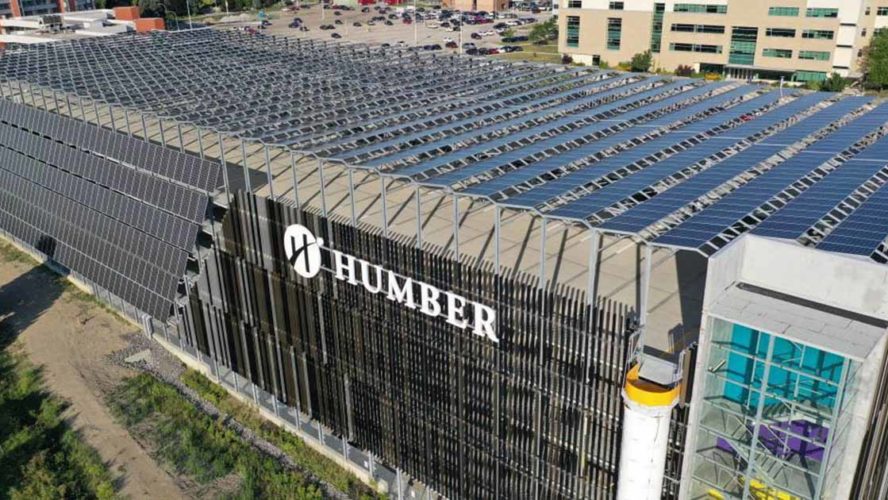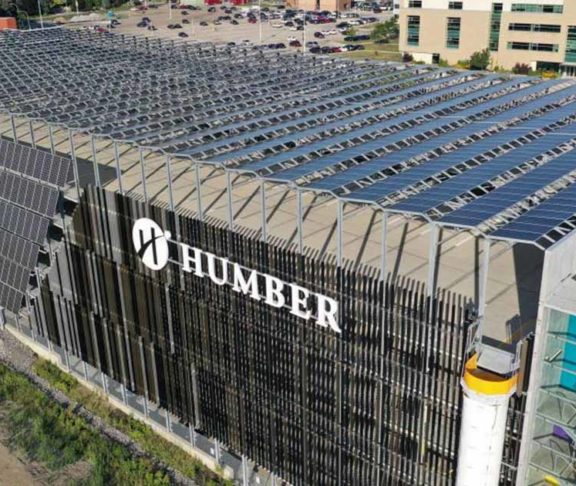
Dr. Martine Spinks
Associate Dean, Design & Built Environment, Faculty of Applied Sciences & Technology, Humber College
New Bachelor of Engineering — the Built Environment degree prepares graduates to tackle climate change through net-zero solutions.
Humber College’s Bachelor of Engineering — the Built Environment degree program prepares graduates for employment in future-forward jobs that exist now but will proliferate in the years to come as part of a more sustainability-focused society.
Sustainability is woven into the three engineering degrees— the Built Environment, Mechatronics, and Information Systems Engineering — offered at Humber College. The Built Environment program was introduced in 2021, and courses are specifically structured to teach students how to design net-zero and climate-positive buildings that are adaptable and resilient for decades to come.
“Buildings are not static concrete bricks and mortar — we don’t see them as that anymore. We see a block of buildings as a network of systems,” says Dr. Martine Spinks, Associate Dean of Design & Built Environment in Humber’s Faculty of Applied Sciences and Technology. “They’re feeding into energy grids, and they’re adaptable. We teach our students to optimize how buildings operate and design them to consider the possibilities.”
Buildings are not static concrete bricks and mortar — we don’t see them as that anymore. We see a block of buildings as a network of systems.
Built environment refers to everything we live, work, and play in, including physical structures like buildings and the infrastructure that supports them. The Built Environment engineering degree program at Humber incorporates elements of architecture, civil engineering, and building systems engineering with a focus on sustainability. In addition to more traditional courses like Statics and Thermodynamics and Heat Transfer, students complete specialization courses in Sustainable Communities Design, Building Automation Systems, and Resilience and Environmental Assessment.

21st-century engineers in a sustainable society
With smaller class sizes and living labs — utilizing the campus’ buildings and systems to learn and experiment — students get a personalized learning experience to become industry leaders.
“Students are learning in spaces that represent the real world. Whereas when you go to a traditional university, you sit in a lecture hall,” says Dr. Spinks. “That’s what is really different about our applied learning environment.”
Humber’s campuses often serve as a living lab for students. For example, students had the opportunity to work side-by-side with industry partners on Humber’s Building NX retrofit project, transforming an inefficient, older structure into a highly insulated air-tight retrofit that resulted in a 90 per cent reduction in greenhouse gas emissions.
Building NX became the first retrofit to achieve a Zero Carbon Building (ZCB) — Design certification from the Canada Green Building Council (CAGBC). This is just one example of the many on-campus teaching tools open to Humber’s engineering students.
“Engineering used to be about binary systems. Now, we’re trying to create a twenty-first-century engineer that doesn’t just tell you what the problem is. They work to understand the problem within diverse communities to design better, more sustainable solutions,” says Dr. Spinks.
The next generation wants a planet that all people can thrive within, and it’s our responsibility to help solve the climate-change problems that society is facing.
Humber’s three engineering disciplines have a common first-year platform. Students then specialize in their chosen field in the Built Environment, Mechatronics, or Information Systems Engineering. In their final year, students come together to develop a capstone project encompassing all forms of engineering into one.
With the provincial government’s Green Investment Fund, roles in retrofitting and other sustainable engineering jobs are in high demand. As a result, graduates of Humber’s engineering degrees will be well prepared for the sustainable careers of the future.
“The next generation wants a planet that all people can thrive within, and it’s our responsibility to help solve the climate-change problems that society is facing,” says Dr. Spinks. “This generation wants it, the government is mandating it, and industry is responding, so we’re integrating sustainability throughout our learning.”




